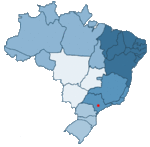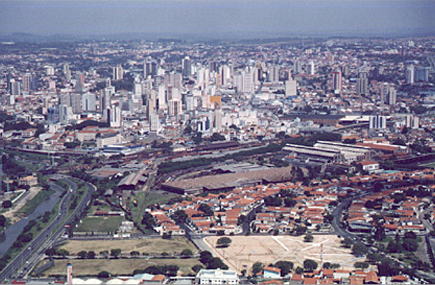Sorocaba
|
|
Sorocaba is a city in southern Brazil, in the southeast of São Paulo State. As of 2004, its population was approximately 554,194. The title of Manchester Paulista was given to the city in the end of XIX century, due to the rapidly increase of English textile industries in the city scenery, along the opening of the most important railways of São Paulo - the Estrada de Ferro Sorocabana (Sorocabana Railway). The metallurgy and steelmaking technologies inherited from the early days gave the city the leading role in mechanical engineering today. Sorocaba's Industrial Park is one of the most important poles of engineering, manufacturing and assembling of the South America.
| Contents |
History
| City of Sorocaba | |
|---|---|

| |
| Geography | |
| Status: | Metropolitan Region, City (1842) |
| Region: | Southeast of Brazil |
| Ceremonial County: | Comarca de Sorocaba |
| Area: Total | 456 km² |
| Admin. HQ: | Sorocaba |
| Geographical coordinates: | 23° 50' S 47° 46' W |
| Politics | |
| Missing image Sorocaba_CoatOfArms.gif Arms of the City of Sorocaba "I fought for a free Motherland" http://www.sorocaba.sp.gov.br | |
Don Francisco de Souza, Governor-General of Brazil (1591 to 1602), believing in the existence of gold in the region, settled the Pelourinho - symbol of the Royal power - as the village Nova Vila de Nossa Senhora da Ponte de Mont Serrat. The gold wasn't found, and the Governor-General returned to the Court. Twelve years later, Don Francisco de Souza changed the name of the village to Itavuvu.
Baltazar Fernandes, member of the expeditions called Bandeirantes, laid the foundations of Sorocaba in the year of 1654. The chapel of Nossa Senhora da Ponte (which now is the Cathedral located in Fernando Prestes square, downtown) was built by him, along the São Bento de Parnaíba monastery (now São Bento monastery) years later. It was also him who brought the first Benedictine monks to teach, assist the poor and the ill, and to give religious assistance to the first inhabitants. The monastery was donated to the Benedictines in the year 1660, wherein Frei Anselmo da Anunciação and Frei Mauro were chosen to assume office. The first streets and houses started to spread around the neighbourhood.
In the year of 1661, Baltazar Fernandes went to São Paulo to require from the Governor-General, Côrrea de Sá e Benevides the title of Village for Sorocaba, which was granted. So, as of 3 March 1661 Sorocaba was known as Vila de Nossa Senhora da Ponte de Sorocaba. The Municipal Council followed shortly, with the main nominees: Baltazar Fernandes and André de Zunega (judges), Cláudio Furquim and Paschoal Leite Paes (city councillors), Domingos Garcia (procurator) with Francisco Sanches (clerk).
With the arrival of colonel Cristóvão Pereira de Abreu in 1773 along his troops, begins the main chapter of the history of Sorocaba: the Tropeirismo.
The transportation of goods in the back of Equidae which traversed the North-South route of the country came across Sorocaba, which was strategically placed in the main route between Rio Grande do Sul, Minas Gerais and Rio de Janeiro. Soon Sorocaba had its own Feira de Muares (equidae fair), where troops from all states came to feed and rest their cavalry on the way to the mineral and forest expeditions, and buy and sell goods, equidae and slaves. Given the growing number of people working in the city, the commerce and the first industries began to appear. Goods bought in Sorocaba were known from across the Country, spread by the merchant troops. The main events of Troperismo comprehended a hundred years of the Sorocaba history, from 1770 to 1870.
During the American Civil War, the English textile industries run out of cotton, cultivated mainly in the South states of USA. The South was the main supplier of white-cotton for the English industries, which were rebelled with the central government of that Country. Soon, producers of England started to search for alternative places to cultivate cotton around the World - one of them was the Province of São Paulo, which Sorocaba was included. In 1862, Lieutenant-Colonel Francisco Gonçalves de Oliveira Machado received the first seeds. The environment and weather were ideal, and the plantation flourished. The first harvest exceeded all expectations, starting another circle of industrial and economic development. Several textile industries from England were built in the city, changing the landscape with chimneys, saw-styled roofs, orange and large brick-built buildings and smoke. During this time, Sorocaba received the title of Manchester Paulista (Paulistan Manchester), given the resemblance with its labouring twin city.
With the opening of the Companhia Sorocabana railway in Jun 20 1872 to transport the cotton production, animals and passengers to São Paulo, Sorocaba had a major leap towards development. Six locomotives and 62 bandwagons were brought from Europe, with seven stations initially planned. Telegraphic services started in April 3 1873. Years later, the railway expanded to the borders of the State, with Estação Sorocabana being the central station.
Industry
It's industrial park is well served with an excellent infrastructure of roads, highways, public transportation, power transmission, telecommunications, waste disposals, gas pipeline and potable water, with more than 25 millions square meters and over 1600 industries. Main economic activities are: Industry Machinery, heavy Metallurgy, Ironmaking and Steelmaking, Automobile Parts, Industry Textiles, Agricultural Equipment, Chemical and Petrochemical, Cement production, Eolic Energy, Pharmaceutics, Paper and Cellulose, Electronics, Telecommunications, Tools, Commerce and Services. It's Tools, Automobile Parts and Pharmaceutics industry are the biggest in Brazil.
Some of the industries which take part in this diversity are: Pratt & Whitney (http://www.pratt-whitney.com/), Enertec (http://www.enertec-leipzig.de), Valeo Global Automotive (http://www.valeo.com), INA-Schaeffler (http://www.ina.de/), Cooper Tools (http://www.coopertools.com/), CASE Corporation (http://www.casece.com/), Lufkin Industries (http://www.lufkin.com/), ZF Friedrichshafen (http://www.zf.com/), FAG Kugelfischer (http://www.fag.de), DANA Corporation (http://www.dana.com/), Villares Metals (http://www.villares.com.br/), YKK Group (http://www.ykk.com/), Wobben Windpower (http://www.enercon.de), Pirelli (http://www.pirelli.com), GM (http://www.gm.com/), Metalac (http://www.spstech.com), Luk (http://www.luk.de/), Allied Signal/Honeywell (http://www.honeywell.com/), Yashika (http://www.yashica.com/site.html), Metso Paper (http://www.metsopaper.com/), Hartmann-Mapol (http://www.hartmann.dk), Aster Pharmaceutics (http://www.aster.com.br/), Sealy (http://www.sealy.com/), Campari (http://www.campari.com/), CSM (http://www.csm.com.br/), Flextronics (http://www.flextronics.com/), Andrew Telecommunications (http://www.andrew.com/), Coca-Cola (http://www.coca-cola.com/), among others.
The Ferroban railway (former Sorocabana Railway and FEPASA) is connected to São Paulo and the Santos Seaport, the major seaport in Latin America. The railway is also an important link to Mercosul, reaching Argentina and Bolívia in its borders.
Sorocaba has also a Dry Port Terminal, which provides efficient road linkages to the various ports and airports of the region including Sorocaba Airport, which has one of the busiest cargo terminals in the State.
Economy
Sorocaba's economic development is 5th in the State, with investments in the order of US$ 3,5 billions, with US$ 3 billions in Gross Internal Product. It's industries exports to over 115 countries, with an income of US$370 millions per year. There are over 8 thousand commerce organizations and another 8 thousand service businesses.
Education
Sorocaba has 4 major universities, being 3 privates: Pontifícia Universidade Católica (PUC), Universidade de Sorocaba (UNISO) and Universidade Paulista (UNIP), and one public: Universidade Estadual Paulista (UNESP).
It has also five colleges: Faculdade de Direito de Sorocaba (FADI), Faculdade de Engenharia de Sorocaba {FACENS), Faculdade de Tecnologia de Sorocaba (FATEC), Instituto Manchester Paulista de Ensino (IMAPES) and Centro de Educação Sorocabano Uirapuru, among other smaller schools. It has also over 400 public, municipal and private elementary and high schools.
Health
The health system is served by a comprehensive infrastructure of hospitals, mainly by the Conjunto Hospitalar de Sorocaba (CHS), a complex which includes the Hospital Regional, Hospital Leonor Mendes de Barros, the Santa Casa Hospital, Santa Lucinda Hospital, the Evangélico Hospital, Samaritano Hospital, Modelo Hospital, the Unimed Hospital complex, Hospital Oftamológico and other four psychiatric hospitals: Jardim das Acácias, Vera Cruz, Mental and Teixeira Lima.
There are also 27 health stations and 3 ER Hospitals, Ambulatório de Saúde Mental and the STD and AIDS Clinic. The number of specializations and hospitals in the city, along Faculdade de Medicina of PUC, Faculdade de Tecnologia de Sorocaba (FATEC) and other private medicine schools, gave Sorocaba the health excellence reference in Brazil. The Anti-HIV Program lead by the local Heath Secretary is referenced worldwide.
Metropolitan Region
Places in the region of Sorocaba include:
- Aluminio
- Araçoiaba da Serra
- Cabreúva
- Capela do Alto
- Iperó
- Itú
- Mairinque
- Porto Feliz
- Salto
- Salto de Pirapora
- Sarapuí
- São Roque
- Votorantim
Resources
Visitors can count with several options for leisure, culture and business while in city. There are many options for accommodations varying from cheap to high-class hotels and lodgings, including International hotel chains like Transamerica Flat, Ibis Hotel, Alpha Inn and others. For the foreigner, there are currency exchange houses and a Convention & Visitors Bureau. Two International Convention Centers are available. The two main newspapers of Sorocaba are Cruzeiro do Sul and Diário de Sorocaba.
Sorocaba is served by an extensive infrastructure of public transportation composed of bus fleets and terminals, in a net that reaches practically every point of the city.
There are many parks opened to the public, historic churches, walking and racing courses, historic monuments, museums, mausoleums and memorials, various spas and stud farms. The municipal Zoo, Zoológico Municipal Quinzinho de Barros, is one of the biggest and well-built Zoos in South America.
Nocturne life in city is plentiful of options, with theaters, cinemas, nightclubs, bars and restaurants with cuisines from around the world.
Geology
Sorocaba is located exactly on the limit between the sediments of Parana Basin (Itararé Group, in glacial and deltaic environments of Permian-Carboniferous age) and crystalline basement (Neoproterozoic). Important granitic batoliths are Sorocaba Massif (I-Type) and Sao Francisco (A-Type). Metamorphic low grade rocks as phyllites, metacalcareous, metarenites, are marine metassediments included in Sao Roque Group. Araçoiaba Ridge or Ipanema Hill comprises of ultrabasic-alkaline intrusion (Early Cretaceous). The ore was exploited from magnetite probably associated to carbonatite body.
Administration
The current Mayor is Vitor Lippi, by the Partido da Social Democracia Brasileira (PSDB). His term started on Jan. 1, 2005 and ends on Dec. 31, 2008.
External links
- Prefeitura Municipal (http://www.sorocaba.sp.gov.br/)
- Câmara de Sorocaba (http://www.camarasorocaba.sp.gov.br/)
- Sorocaba On-line (http://www.sorocaba.com.br/)
- Cruzeiro do Sul On-line (http://www.cruzeironet.com.br/)
- Projeto Memória (http://memoria.fua.org.br/)
- Estrada de Ferro Sorocabana (http://www.geocities.com/trens_efs/efs.html)
- Jornal do Município On-line (http://www.sorocaba.sp.gov.br/secoes/prefeitura/secretarias/juridico/jornal.php)
- Current time in Sorocaba (http://www.timeanddate.com/worldclock/city.html?n=629)
- Current wheater in Sorocaba (http://www.weather.com/outlook/travel/businesstraveler/local/BRXX0237?from=search_city)
- About the Flag of Sorocaba (http://www.crwflags.com/fotw/flags/br-sp-so.html)de:Sorocaba

